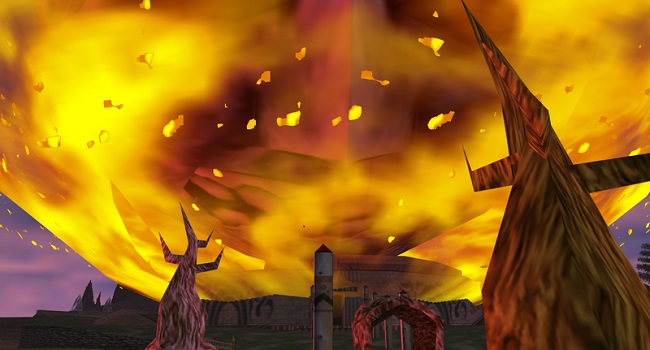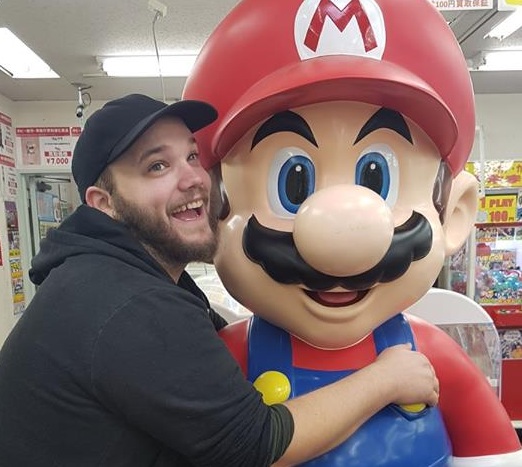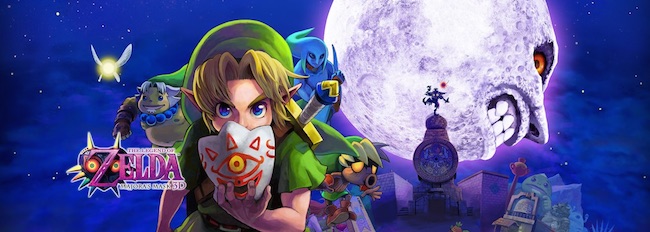
The main story of Majora’s Mask is standard apocalypse-averting Zelda fare though there’s so much more to the game what appears on the surface. While searching for Navi, the fairy that accompanied him during his adventures in Ocarina of Time, Link gets knocked down and robbed by a Majora’s Mask adorned Skull Kid. While chasing him down, Link rushes through Aonuma-senpai’s interpretation of Alice in Wonderland’s “falling down the rabbit hole” and finds himself in Clock Town, Termina. Not done with his dickishness, Skull Kid starts to pull the moon down towards the Earth and kicks off a very slow apocalypse. Of course, it’s up to Link to stop it, and he answers the call with his trusty sword, shield, can-do attitude and an array of face-wrenching, form altering masks.
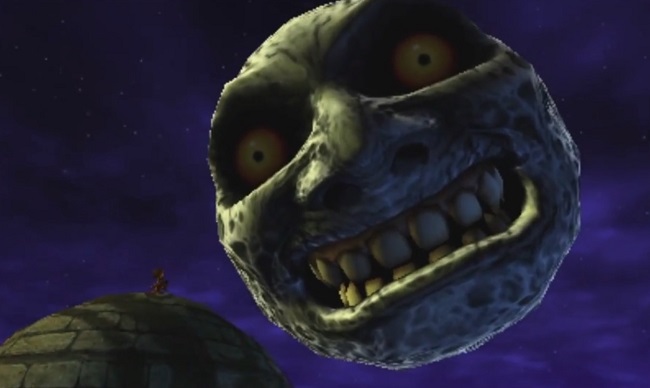
Everyone is also weirdly okay with the moon having a face, and that it has that face.
There are so many themes going on in this game and, due to the cryptic nature of the game, the “point” of its narrative has been the subject of much online debate. Death and how it affects people is pretty obviously one of the major themes, as it marks just about every major event in the game in some way. It’s some heavy shit to deal with in what is ostensibly a kids game, though it still manages to keep the kid gloves on most of the time. While the game also has recurring moments about family, duty, friendship, and many other noble (and staple Zelda) themes, it’s the way the game considers death that I like the most. It forces the player to consider the aftermath, almost uncomfortably at times, of the main mechanic of every Zelda game. This alone is something that makes Majora’s story/stories stand out from the rest of the franchise.
Majora’s Mask’s story (say that three times*) is an interwoven series of smaller, semi-related stories that form an almost mosaic-like narrative. The main story line is fairly self-contained, but it lacks any greater meaning without the context that many of the side-quests provide. It’s not a case of the main story being weak, either; Majora’s Mask is one of the greatest and most emotionally impactful stories in the franchise. A personal and tangible connection is built between the player and the world throughout the game, with Clock Town and its people feeling especially familiar and alive by the end. It’s because of how well it characterises the world that’s in peril, how it places you in that world as a total stranger and still makes you want to care very deeply for everything in it. Thankfully, very little in the way of narrative has been changed in Majora’s Mask 3D (MM3D) and none of it major.
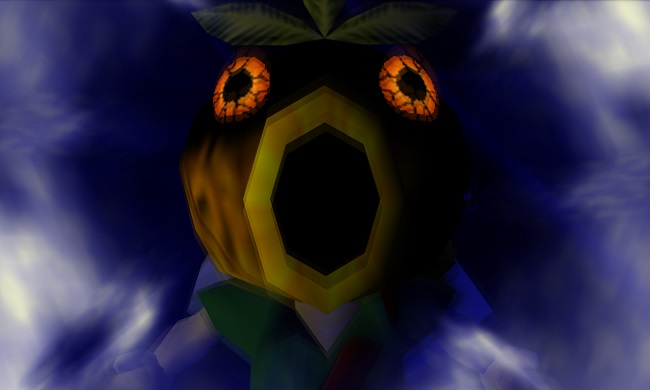
Including NPC’s not flipping out when you start painfully switching species in front of them.
The path you take while completing the main storyline will bring you to a few of these characters at various points out of necessity, but you’ll likely pursue many of the side quests out of sheer curiosity. There’s a great sense of mystery about Majora’s Mask, with the focus of gameplay shifting from exploration of the world to familiarisation. There is a lot of backtracking throughout, even through the four Temples though that’s not necessarily a bad thing. When going back to a place you think you’ve explored entirely, you might find a whole new area to explore. You’ll encounter memorable fights after figuring out a puzzle that you might have walked through dozens of times without even realising it was there. When speaking to someone you’ve spoken to dozens of times, but wearing a specific mask, they might turn out to have the most unusual connection to the most unexpected characters.
That isn’t to say that there isn’t still a healthy dose of adventuring and/or dungeoneering in the game, which would be more typical of other Zelda titles. If anything, this larger focus on narrative often gives way to more interesting scenarios to ply your skills against outside of the standard Temple raiding for sacred whatever’s. The Temples themselves, while major milestones, are far from “the point of the game,” as it sometimes feels in other Zelda titles. There’ll always come a time when you need to hack and slash your way through beasties, but to find them you have to listen to people around you and learn the idiosyncrasies of the world. It’s a really rewarding experience, much more so than “go to “X” and swing your sword until “Z” falls down.”
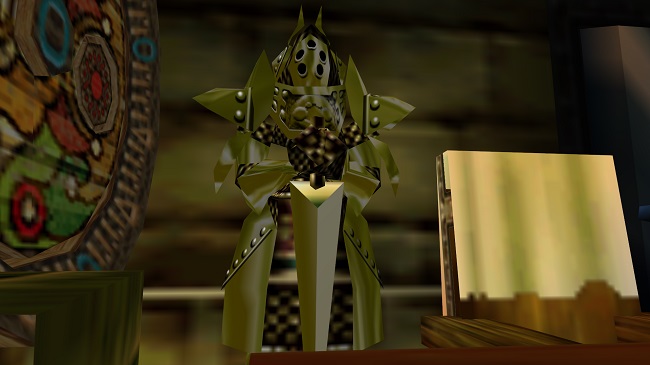
There is still much sword swinging at Z’s in X’s, but it’s the “Y” that makes it so good.
The unique part of Majora’s design, however, is the day tracker: the on-screen, three-day counter that continuously counts down to the apocalypse. When Link reaches the end of the three days, and the Moon’s ugly face is filling the sky, he can play the Song of Time to return to the beginning of those three days. Doing this would save the game in the N64 version, however, this has been removed for MM3D in favor of fixed save points that have been scattered around the world. I actually prefer this as it doesn’t make the game less difficult, it means there isn’t so much goddamn waiting and frustrating repetition. Majora’s already a pretty difficult game that requires a lot of problem-solving, and trial and error, in pursuit of the main quest line, let alone the side quests. Even with the improved Bomber’s Notebook (more on that in a moment), you’ll be reloading a lot.
Being able to reload a save after making a small mistake is so much better than having to start the entire day cycle again, which would be required for most time-sensitive quests. This mistake could be as simple as not having figured out a particular section of a quest chain in time for its next step. In the N64 version, this would mean having to go all the way back to the beginning and redo the quest up to that point – it got frustrating. It doesn’t create difficulty; it just creates the illusion of difficulty by extending the length of the game through arbitrarily making the player repeat stuff over and over. It wasn’t a great mechanic, and MM3D’s solution fixes that while still maintaining a degree of difficulty by making the save points few and far between.
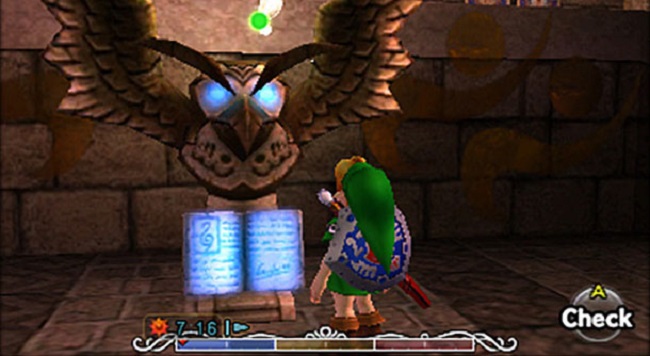
Thank you, based owl.
The HUD in MM3D has been moved down to the touch screen, just as with OoT3D, to allow the player to see as much of the play screen as possible. The day tracker, however, has been ominously left at the bottom of the play screen, constantly reminding you of the impending moon-death that awaits you all. Creepy. The best example of Majora’s re-design is the Bombers Notebook, essentially your quest log, allowing touch control on the bottom screen and displaying all the information on top. You can even set alarms along the timeline while trying to complete quests around the map. The touch controls are simple and easy to use, with the buttons being close to the edge of the screen, so you don’t have to let go of the console to use them. MM3D has a fantastic design overall, with more thought given to refining existing features instead of redesigning them entirely.
The game controls just as well as OoT3D, and definitely better than the original game did, though it should be noted that I played the game on a New 3DS. The addition of the c-stick made the camera controls really easy to manage, but I can’t vouch for how it would work on the old model 3DS’. It played smoothly, as well, with no lag to speak of and fast loading times all around. There have also been some small changes to speed up gameplay in general, with skippable mask transformation scenes being that for which I am most grateful. This is typical of all the changes in gameplay mechanics, including the aforementioned save spots and tightening up the Goron Link and Zora Link controls.
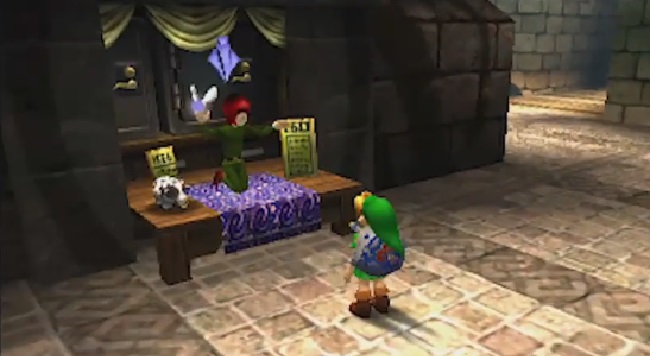
And the bank is right next to the warp point now, which is just, oh my god, sublimely convenient.
MM3D is a gorgeous game and Grezzo have done an amazing job of updating the visuals and sounds from the N64 version. There’s a thematic darkness of tone throughout the game, but that doesn’t mean that everything around you is drab, washed out and quite. There’s an enormous amount of colour and music in Majora’s Mask, with lighting used extensively to communicate how the game wants you to feel. What struck me especially was the way the days progressed, from a clear, sunny day on the first day, raining and storms on the second, and the bizarre weather effects on the third. The sky turns into an incredible array of swirling reds, oranges, and purples on the last day and the lighting becomes dimmer. When combined with unusual, despondent music and quickly diminishing time, it hammers home that “end of the world” feeling.
Despondent really is the best way to describe the music of Majora’s Mask, it has such an enjoyable melancholy about the entire arrangement. Some of the songs that Link plays are cheerful, and some sorrowful, though they’re always very melodic regardless of the instrument that he plays them on. Most of these songs are also closely tied to moments in the game that represent hope, love or even redemption. They’re a great contrast to the discordant beat that a lot of Majora’s backing music has. The long, creeping, mournful tones, and sudden, jarring cymbal clashes that follow you during most of the game communicate so much despair.
*Never forget that I can make you do things just by typing them.
 Complex, amazing narrative
Complex, amazing narrative
 Classic Zelda gameplay
Classic Zelda gameplay
 Great re-design
Great re-design
 Superb soundtrack and visuals
Superb soundtrack and visuals
 Arguably better than OoT
Arguably better than OoT
 Someone will hate me for this
Someone will hate me for this
Perfect isn’t a word I like to throw around a lot; it’s nigh-impossible to define and is entirely subject to any one person’s opinion of what “perfect” even is. Majora’s Mask is such a strange game, unique by even Zelda standards in many ways, and in a good way. It combines highly stylised visuals and music, fantastic narrative(s), unique design, and classic Zelda gameplay to create something far greater than the sum of its parts. It was already a great game, and MM3D has smoothed out the gameplay and design problems that the N64 version had to really make it shine. Some people might say that these changes greatly diminish the game, lessening both its difficulty and faithfulness to the original, and that MM3D is a bad re-release because of this…
